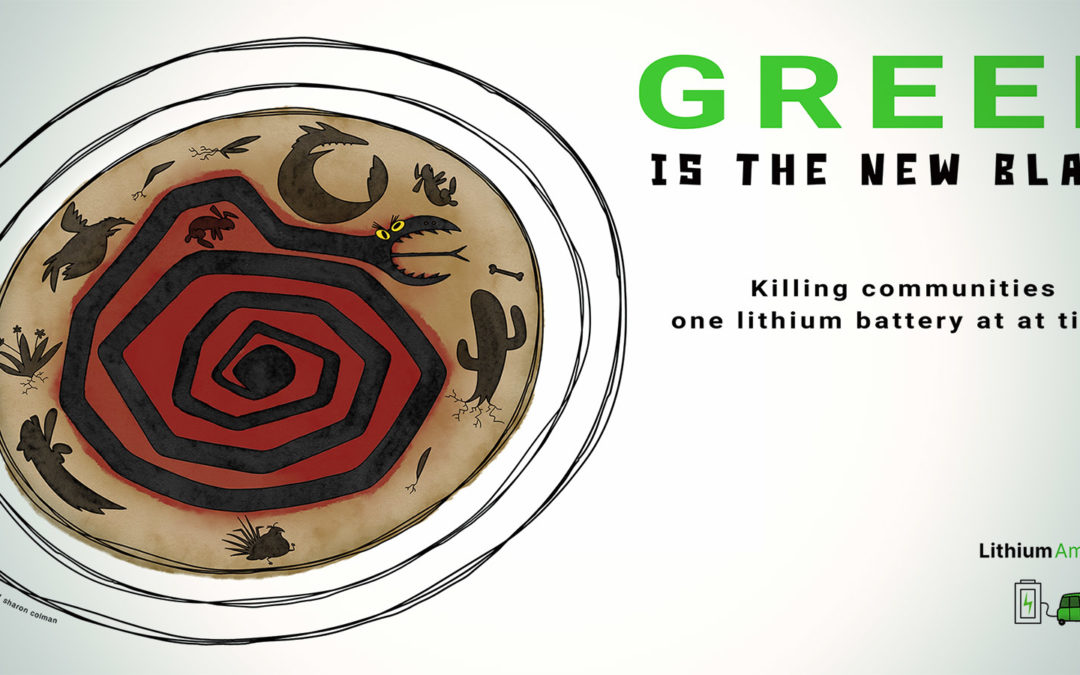The implications of replacing cars (and other vehicles) with electric vehicles (EVs) are many. As we’ve previously discussed, this includes perpetuating car culture and the devastating damage to the natural world caused by roads, and the massive increase in mining that will be required to source the materials to build all these new cars, the batteries that supply their power, and the materials with which to build the power sources for the electric grid.
A recent article “The Hard Math of Minerals” describes how “[s]caling up solar, wind, and batteries also means scaling up the mining of the refined minerals they require,” and that “[t]he energy transition, as it’s being conceived today, will create a need for tens of gigatons of materials for solar and wind generation, grid storage, and car batteries.” The International Energy Agency (IEA) describes this as a “shift from a fuel-intensive to a material-intensive energy system” and estimates this energy plan “would increase demand for minerals such as lithium, graphite, nickel, and cobalt rare earths by 4,200%, 2,500%, 1,900% and 700%, respectively, by 2040.”
“In a recent report from the Geological Survey of Finland, researchers considered the minerals implications for achieving a so-called full transition; that is, using solar and wind to electrify all ground transport as well as to produce hydrogen for both aviation and chemical processes. They found the resulting demand for nearly every necessary mineral, including common ones such as copper, nickel, graphite, and lithium, would exceed not just existing and planned global production capabilities, but also known global reserves of those minerals.”
This demand for materials for a “material-intensive energy system” will significantly–and catastrophically–increase mining around the world. If you’ve been following Protect Thacker Pass, then you will already know that mining is incredibly destructive and is responsible for much of the toxic waste that enters the environment annually.
In the past we’ve talked in more detail about the impacts of mining lithium, and also cobalt. Cobalt gets a lot of press because of the human rights abuses in the Democratic Republic of the Congo (DRC) where most of the world’s current supply of cobalt is mined, and because the mining industry is now eyeing the deep sea to mine the ongoing supplies of nickel and cobalt required for batteries and other technologies, mining that would be absolutely devastating to the world’s oceans and the marine life who lives there.
But the main ingredient in EV and grid storage batteries is not cobalt, nor is it even lithium. No, the main ingredient is actually graphite. Battery anodes are made almost entirely out of graphite. Graphite helps a battery charge faster–much faster–and helps a battery hold its charge longer, too.
Fast charging is critically important for public EV acceptance. We all know that the only way people will accept EVs as a substitute for gasoline-fueled cars is if they can recharge their car’s batteries while on a road trip almost as fast as they can fill up a car with gas.
Graphite is key to fast charging, and thus to the EV industry. The graphite used in batteries comes in two forms: flake graphite, the kind of graphite mined from the ground, and synthetic graphite. Flake graphite is good, but synthetic graphite works even better.
So, you might be asking: what is synthetic graphite, and how is it made? The answer: synthetic graphite is made out of oil and coal. Yup. The main ingredient in the batteries that supply power for those “clean” and “green” electric vehicles and the grid battery storage for “clean” electricity is made out of fossil fuels.
The primary feedstock used for making synthetic graphite is petroleum coke and coal tar pitch. Petroleum coke is made from the stuff at the bottom of a barrel of oil–the nastiest, dirtiest, heaviest oil (most often used as bunker fuel in global shipping because the emissions from burning it are so high). Refineries bake this oil at extremely high temperatures to turn it into petroleum coke, a pure form of carbon. This coke is then mixed with natural flake graphite (the kind mined out of the ground) and coal tar pitch, and then baked, sometimes several times, again at very high temperatures. The resulting graphite is then ground into a fine powder. (See https://www.gab-neumann.com/Impervious-graphite-manufacturing-process for a full description of the process.)
Finally, the fine synthetic graphite powder is coated on to copper sheets, and the process of turning oil, coal, and flake graphite into graphite anodes for batteries is complete.
The purest forms of synthetic graphite are created at temperatures greater than 2000 degrees Celsius. Baking petroleum coke and the graphite-coal tar pitch binder at extremely high temperatures improves the capacity of the resulting graphite. The only way to supply constant high heat for industrial processes is with fossil fuels.
The baking process for graphite is so energy intensive, the UK sends petroleum coke to China for baking because if it were done in the UK, the emissions from high temperature baking would be too high to allow the UK to meet its emissions goals. As we know, outsourcing the dirtiest, highest emissions-producing extraction and manufacturing to developing countries is commonplace. It’s done so that wealthy countries like the US and the UK can meet their emissions goals on paper, while foisting the environmental pollution on countries with lax environmental laws, countries not bound by the same emissions requirements under international agreements.
Author Ed Conway, in his recent article about battery gigafactories in the UK, acknowledges that using petroleum coke and coal tar pitch to make a key ingredient in batteries is not a good look. He writes, “no one much likes to discuss the fact that you need crude oil to make batteries, or that you need a dirty, energy-intensive set of processes to process it into the coke and then the graphite that make the world’s batteries work.” Indeed. As we’ve argued, the propaganda around “clean” and “green” is relentless. The corporations and governments pushing new technologies, including EVs and batteries, don’t want us to look under the covers of how this technology is made, because if we did, we might indeed be concerned. Where else have we seen corporations in collaboration with governments hiding the truth about the dirty implications of their products? Oh yes, the cigarette manufacturers and the fossil fuel companies. The more things change, the more they stay the same.
Unfortunately, Mr Conway’s conclusion is that we’ll need oil refineries to continue existing into the future in order to supply materials like petroleum coke, coal tar pitch (and don’t forget, sulfur for refining materials like lithium from clay and rock) in order to make the materials like steel, silicon, and graphite required for so-called “clean” technology. He writes, “Eliminating greenhouse gas emissions … will also feature aspects we might be a little less comfortable with: digging vast quantities of stuff out of the ground, racing to secure resources before other countries do; and relying on oil refineries like this, both in the short term and potentially the long term too.”
As we’ve said all along, we can’t save the planet by destroying the planet. Continuing to rely on non-renewable resources to supply materials for a materials-intensive energy future makes no sense, if you think about it logically. Attempting to transition the world off fossil fuels to “clean energy” when supplying that “clean energy” requires fossil fuels simply makes no sense. Arguing that a lithium mine is good for mitigating climate change when that same lithium mine will release the greenhouse gas emissions of a small city makes no sense, just like arguing that we need more batteries when making the ingredients in the batteries requires fossil fuels makes no sense.
The propaganda we are all exposed to day in and day out–that we “need” more energy, that we “need” cars, that we “need” an infinitely growing economy on a finite planet–is lies designed to keep the ecocidal culture we live in going. Unfortunately, these lies–if we believe them–will lead humanity to destroy what’s left of the living planet. Don’t believe them.
~~
“Green is the new black” art by Sharon Colman.


Recent Comments